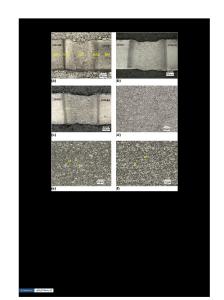Microstructures and mechanical properties of metal inert-gas arc welded joints of aluminum alloy and ultrahigh strength
- PDF / 895,332 Bytes
- 11 Pages / 584.957 x 782.986 pts Page_size
- 39 Downloads / 14,822 Views
ssimilar metal inert-gas arc welding of aluminum alloy and ultrahigh strength steel was studied. The weld appearance was improved when welding wire was directed toward steel groove middle. The Al–steel joints have welding–brazing characteristics and include weld zone (WZ), bond zone (BZ), and interface zone (IZ). The welds with Al–Mg and Al–Cu welding wires consist of a-Al and b-Al3Mg2, and a-Al and Al2Cu, respectively. The IZ contains needle-like Fe4Al13 and lath-shaped Fe2Al5 layers. With increasing welding current, the interface layer thickness and joint cracking sensibility increased due to enhanced heat input and tensile stress in the joints. They were decreased effectively when using Al–Cu welding wire, as the constituent Cu could restrain the growth of interface layer and lower its hardness and brittleness. In particular, Al–Cu welding wire elevated the tensile strength of the Al-steel joints from 65 MPa for Al–Mg wire to 128 MPa.
I. INTRODUCTION
With the development of global economic integration, global resources have been becoming increasingly scarce. To achieve the purpose of energy-saving and emissionreduction, the strategy of vehicle lightweight has become a national trend in transportation industry. Recently, the realization approaches and key technologies to achieve the vehicle lightweight at home and abroad mainly include three aspects: one is lightweight structure design and optimization, the second is the application of lightweight materials and the third is the use of new manufacturing techniques. Ultrahigh strength steel is major auto lightweight material, followed by aluminum alloy, magnesium alloy, composite material and plastic, etc. Therefore, in vehicle design and manufacture, using lightweight structure design and increasing the ultrahigh strength steel, aluminum alloy, and magnesium alloy in the use of lightweight materials are the most direct and effective way to realize the vehicle lightweight, energy-saving, environmental protection, and safety.1–4 Aluminum–steel dissimilar metal structure can give full play to respective advantages of aluminum and steel. It has merits of light weight, high strength, good thermal conductivity, and good economic returns. And the joining of aluminum alloy to steel has attracted wide publicity and shows a bright prospect in fields of aerospace, shipbuilding, and automobile manufacturing. Contributing Editor: Jürgen Eckert a) Address all correspondence to this author. e-mail: [email protected] DOI: 10.1557/jmr.2016.487
As a consequence, the dissimilar metal joining of aluminum alloy to ultrahigh strength steel becomes the key problem to be solved. However, the dissimilar metal joining of aluminum to steel is very difficult due to the formation of brittle and hard Fe–Al intermetallic compounds (IMCs) in the interface.5–7 In the recent study, various welding processes have been conducted to hopefully address this issue. To obtain a highquality joint of aluminum and steel, some welding methods have been studied. Lin et al.8 joined 5A06 aluminum alloy and S
Data Loading...











